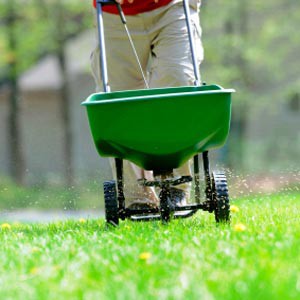
 A fertilizer is a material that supplies one or more of the essential nutrients to plants. When these nutrients are limited or unavailable, turf grass will often show deficiency symptoms such as reduced growth, weak and spindly plants, and poor color. Fertilization cannot be neglected if you want to maintain a great lawn. In fact, all turf professionals will tell you that the best defense against weeds is a thick, well-fertilized turf which helps choke out undesirable weeds.
A fertilizer is a material that supplies one or more of the essential nutrients to plants. When these nutrients are limited or unavailable, turf grass will often show deficiency symptoms such as reduced growth, weak and spindly plants, and poor color. Fertilization cannot be neglected if you want to maintain a great lawn. In fact, all turf professionals will tell you that the best defense against weeds is a thick, well-fertilized turf which helps choke out undesirable weeds.
Most of the fertilization supplied by LawnAmerica is in the form a dry granule. Nitrogen is the most important element supplied by fertilizers, followed by Potassium and Phosphorus. Our fertilizer analysis will vary somewhat during the season, but during the main part of the growing season, we’ll use something like a 24–0–10. This means that 24% of the fertilizer is Nitrogen, 0% Phosphorus, and 10% is Potassium. We also have secondary and micronutrients such as Calcium, Iron, Magnesium, etc. in our blends.
Nitrogen is the element, which is mainly responsible for the nice, green color of turf. It also stimulates growth, which is good for the plant. Excessive growth however can put a real strain on your mowing frequency and can actually harm your root system. At LawnAmerica, we try to apply the proper amount of Nitrogen with each application, in order to provide good color, while not overdoing it to the extent of harming the root system. Too much Nitrogen is just as bad as not enough. Many of our fertilizers also contain a portion of the Nitrogen in the form of a slow-release product, which will provide a longer-lasting and more consistent color response.
Some types of grass, such as St. Augustine and Tall Fescue, really benefit from organic fertilization during the summer. Organic fertilizers have the advantage of being almost 100% slow-release, which is good especially during the summer months. They have other benefits, such as stimulating more microbial action in the soil, and supplying micronutrients such as Iron.
They are not without some drawbacks though, such as being more costly to apply. Contrary to popular belief, organic fertilizers are not more “safe” compared to conventional mineral and synthetic organic fertilizers. If you really desire an organic fertilizer approach to your lawn, contact us and we can provide that for you.
All Fertilizers Need to be Watered Into the Soil.
We always leave watering instructions with each invoice, which tells you when to water. Generally, during the spring and fall immediate watering is not necessary. You can just wait until Nature provides water or your watering system kicks on. During hot, dry summer conditions is the time that it is more important to water in fertilizer with a day of application if possible. It’s not that dry fertilizer applied on dry soil is going to burn the turf, because it won’t. You can lose some of the nitrogen to the atmosphere if dry fertilizer is left on the turf surface for several days without being watered into the soil. If you don’t water thoroughly enough, you will increase the chances of turf burning due to hot conditions.
Our 6-Step Program supplies the best rate of fertilizer for warm season grass Lawns, with 4 full applications of granular fertilizer applied every 6 weeks from early-spring through early fall.
